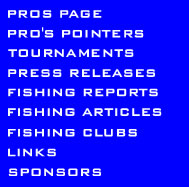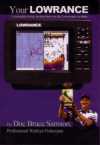
Click
here for Bruce Samson's Great New Instructional Interactive
DVD
|
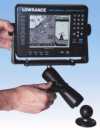
Ram 111-U The ultimate Electronics mount
Click
here for more info
or to order |
|
Fishing
articles by John Kolinski on Walleyes Inc. Your one stop internet
fishing source |
| Editor's note: John Kolinski is the 2002 Professional
Walleye Trail Angler of the Year, the 2003 Illinois River
RCL winner and a 17-time championship qualifier. He is the
only angler to fish the PWT and B.A.S.S. at the same time.
His articles can be read in numerous Midwestern outdoor
publications and at several web sites. Kolinski is sponsored
by Triton Boats, Mercury Motors, Humminbird Electronics,
Yo-Zuri fishing line, Normark/Storm Lures, MinnKota, Uncle
Josh, Tempress Rod Holders, Off-Shore Planer Boards and
Optima Batteries |
For a lot of Midwest anglers, walleyes plus April equals
rivers.
And why not? These flowages, both large and small, serve
as hosts for massive runs of spring walleyes compelled by
nature to perform their annual spring spawning ritual.
But fishing rivers is like trying to hit a dancing knuckleball.
Changes in water levels, current flow, water clarity and
water temperature that are so frequent in April give the
advantage to the pitcher.
There are also populations of fish in our lakes and reservoirs
that take care of their procreation out in open water. And
many of these locales bring together the best of both worlds
where they intersect with smaller rivers and creeks.
Fishing lakes is more like sitting on a fastball. Conditions
tend to be affected less dramatically by weather developments.
You know what you're going to get, and it's up to you to
put a good swing on it.
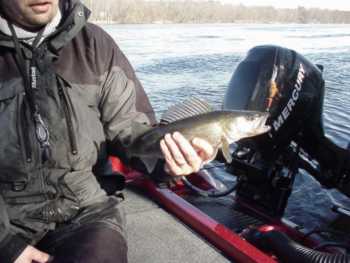 |
Identifying likely April walleye locations
on lakes and reservoirs is largely a matter of structure
and bottom content. Walleyes prefer to spawn over
gravel or rock, although sand will do in bodies of
water where there isn't much hard structure. Nature
also tells these fish to deposit their eggs in places
like reefs or rip-rap where moving water will help
them hatch and disperse the fry before they can be
wiped out by predators. |
Transitions from soft to hard bottom are also great target
areas when other structure is lacking.
Choose a presentation that is most effective for the structure
you're fishing.
For example, drifting or dragging jigs is a staple on the
sand flats in locales like Mille Lacs and Winnibigoshish
and on the reefs of the Great Lakes and Lake Winnebago.
I try to keep my line at no greater than a 45-degree angle
when drifting jigs, and I use the lightest jig I can based
on wind and depth.
Choosing an aquadynamic head style will allow you to fish
lighter. Fin-Tech has a wide selection of drift-friendly
jigs designed to slide through the water with minimal resistence.
Tip your jigs with whatever species of baitfish is dominant
in that body of water. In some lakes, it's shiners. In others,
it might be fathead minnows. And try to create a tight profile
by running the hook into the bait's mouth then out behind
its head rather than simply hooking it through the lips.
Your bait will stay on the hook better, it will be harder
for fish to rip it free without getting hooked, and strikes
will be more obvious. Don't worry about the fact that the
minnow or shiner won't live very long after impaling it
in this manner. In fact, they often do live a long time
and if they don't, that's OK, too, because the bait is still
fresh and it's moving through the water.
If your target area is a soft-to-hard transition or a reef
where debris is fouling your jigs, rigging might be a better
option. Use an in-line slip sinker heavy enough to let you
fish at a 30- to 45-degree angle followed by a plain bait
hook and either a minnow, shiner or even a leech. Snells
should be no less than six feet in length, although I've
had days where stretching them out to as much as 10 feet
doubled my catch when the walleyes were fussy. Sometimes,
adding a colored bead in front of the hook can make a difference,
too.
Whether you're drifting with jigs or long-lining live bait,
keep it slow. When wind conditions permit, I let my MinnKota
Engine Mount 101 dictate the speed of my boat, but if it
gets too windy and boat control becomes an issue, I'll toss
out a MinnKota drift sock for speed control.
Trolling is another productive option that allows you to
target larger areas. In general, walleyes prefer to spawn
under the cover of darkness. They will move onto shallow
reefs or shoreline rip-rap at night to take care of their
business or explore spawning areas, but they'll slide back
to deeper water as the day becomes brighter.
Two keys to catching these fish are your selection of baits
and your trolling speed. Cold-water walleyes aren't likely
to chase a fast-moving lure with violent action, so I break
out the Normark Minnow Raps and X-Raps, which fit in between
tight-wobbling Shad Raps and the gentle action of a Floating
Rap or Husky Jerk. Spread your lures out with a set of Off-Shore
planer boards, and slow it down to 1 1/2-1 3/4 mph and give
the fish a good look and a good chance to gobble it.
It's important, also, to make good use of your electronics.
I've found a lot of April walleyes suspended in the upper
few feet of the water column over deeper water adjacent
to structure, probably because the top layer is a few degrees
warmer than the depths. Even if they're not quite ready
to spawn, walleyes seek out warmer water to help facilitate
the process and relieve themselves of that heavy burden
of eggs. Because these fish may scatter when a boat passes
over them, Humminbird's side-imaging technology gives me
a look at what's around my Triton as well as underneath
it.
In many locales, the mouths of creeks and rivers provide
some outstanding April fishing.
Because all walleyes don't spawn at exactly the same time,
it's the best of all worlds. You can intercept fish that
are moving into a river system to spawn, while you can also
catch others that are leaving the system after taking care
of their business. And in many situations, you will find
pockets near river and creek mouths where postspawn walleyes
stack up in shallow water to recover from spawning.
A great way to target these fish is vertical jigging along
breaklines that serve as travel corridors where rivers and
creeks dump into the main lake. Trolling is another effective
way to work these areas thoroughly.
And if the water temp has climbed into the upper 40s and
you are looking at more of a post-spawn situation, don't
be afraid to break out the crawler harnesses and target
the shallow, muddy flats and bays post-spawn walleyes seem
to favor because of the warmer water and availability of
easy forage. Some of the biggest walleyes of the year are
caught in 2-4 feet of water this time of year.
April is definitely transition time in the walleye world,
but it's also a time when large concentrations of fish can
be found in predictable locations.
Rivers are great if you can hit a knuckler, but don't forget
about your lakes and reservoirs.
You might just Knock one out of the park.
|
|
Please
Check Out these links below to our site Sponsors |
|
|
|
|
| |
|
|
|
|
|
|
|
|
|
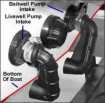
Survivor Livewell Intake
System on
"The Run"
Click
Here For
More Information |
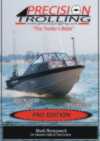
New Precision Trolling Pro Edition With Plastic Pages and
Easily Updateable click
here for more information
|
|
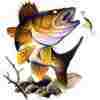 Check
out our T-shirt Line Now in colors and long sleeves
Check
out our T-shirt Line Now in colors and long sleeves |
Church Tackles Walleye Planer Board
 Click
here for more info or to order on-line
Click
here for more info or to order on-line |
|

